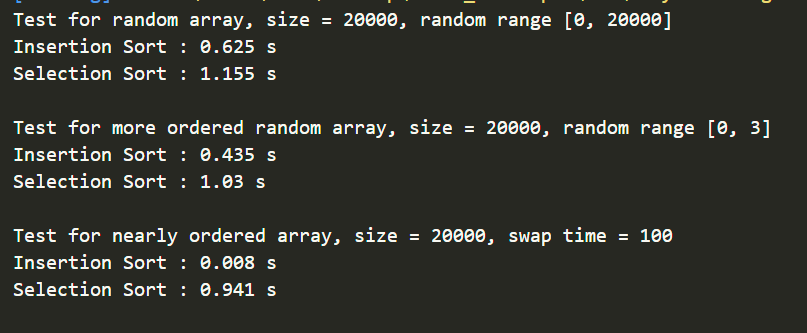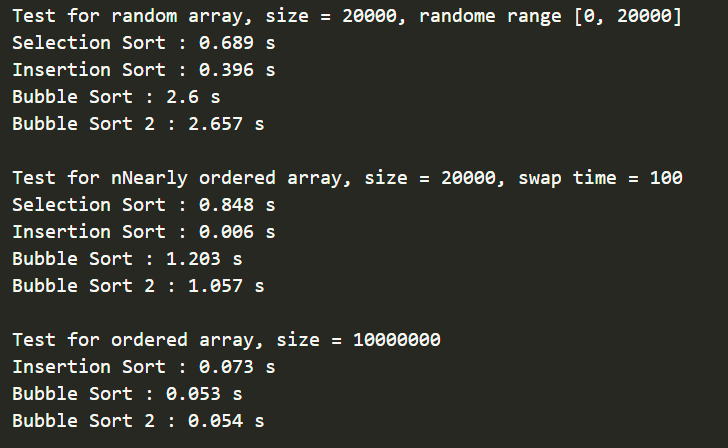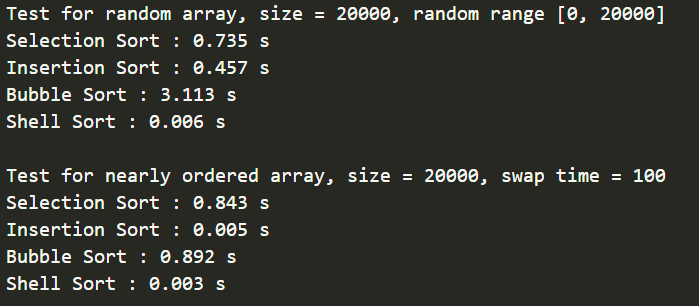选择排序
#include <iostream>
#include <algorithm>
using namespace std;
void selectionSort(int arr[], int n)
{
for (int i = 0; i < n; i++)
{
// 寻找[i, n)区间里的最小值
int minIndex = i;
for (int j = i + 1; j < n; j++)
if (arr[j] < arr[minIndex])
minIndex = j;
// 使用#include <algorithm>
swap(arr[i], arr[minIndex]);
}
}
int main()
{
int a[10] = {10, 9, 8, 7, 6, 5, 4, 3, 2, 1};
selectionSort(a, 10);
for (int i = 0; i < 10; i++)
cout << a[i] << " ";
cout << endl;
return 0;
}
使用函数模板
Student.h
#ifndef INC_02_SELECTION_SORT_USING_TEMPLATE_STUDENT_H
#define INC_02_SELECTION_SORT_USING_TEMPLATE_STUDENT_H
#include <iostream>
#include <string>
using namespace std;
struct Student{
string name;
int score;
// 重载小于运算法,定义Student之间的比较方式
// 如果分数相等,则按照名字的字母序排序
// 如果分数不等,则分数高的靠前
bool operator<(const Student& otherStudent){
return score != otherStudent.score ?
score > otherStudent.score : name < otherStudent.name;
}
// 重载<<符号, 定义Student实例的打印输出方式
// * 很多同学看到这里的C++语法, 头就大了, 甚至还有同学表示要重新学习C++语言
// * 大家也完全可以使用自己的方式书写代码, 最终只要能够打印出结果就好了, 比如设置一个成员函数, 叫做show()...
friend ostream& operator<<(ostream &os, const Student &student){
os<<"Student: "<<student.name<<" "<<student.score<<endl;
return os;
}
};
#endif //INC_02_SELECTION_SORT_USING_TEMPLATE_STUDENT_H
编写
#include <iostream>
#include "Student.h"
using namespace std;
template<typename T>
void selectionSort(T arr[], int n){
for(int i = 0 ; i < n ; i ++){
int minIndex = i;
for( int j = i + 1 ; j < n ; j ++ )
if( arr[j] < arr[minIndex] )
minIndex = j;
swap( arr[i] , arr[minIndex] );
}
}
int main() {
// 测试模板函数,传入整型数组
int a[10] = {10,9,8,7,6,5,4,3,2,1};
selectionSort( a , 10 );
for( int i = 0 ; i < 10 ; i ++ )
cout<<a[i]<<" ";
cout<<endl;
// 测试模板函数,传入浮点数数组
float b[4] = {4.4,3.3,2.2,1.1};
selectionSort(b,4);
for( int i = 0 ; i < 4 ; i ++ )
cout<<b[i]<<" ";
cout<<endl;
// 测试模板函数,传入字符串数组
string c[4] = {"D","C","B","A"};
selectionSort(c,4);
for( int i = 0 ; i < 4 ; i ++ )
cout<<c[i]<<" ";
cout<<endl;
// 测试模板函数,传入自定义结构体Student数组
Student d[4] = { {"D",90} , {"C",100} , {"B",95} , {"A",95} };
selectionSort(d,4);
for( int i = 0 ; i < 4 ; i ++ )
cout<<d[i];
cout<<endl;
return 0;
}

算法测试辅助工具
SortTestHelper.h
#ifndef INC_03_SELECTION_SORT_GENERATE_TEST_CASES_SORTTESTHELPER_H
#define INC_03_SELECTION_SORT_GENERATE_TEST_CASES_SORTTESTHELPER_H
#include <iostream>
#include <ctime>
#include <cassert>
using namespace std;
namespace SortTestHelper {
// 生成有n个元素的随机数组,每个元素的随机范围为[rangeL, rangeR]
int *generateRandomArray(int n, int rangeL, int rangeR) {
assert(rangeL <= rangeR);
int *arr = new int[n];
srand(time(NULL));
for (int i = 0; i < n; i++)
arr[i] = rand() % (rangeR - rangeL + 1) + rangeL;
return arr;
}
// 打印arr数组的所有内容
template<typename T>
void printArray(T arr[], int n) {
for (int i = 0; i < n; i++)
cout << arr[i] << " ";
cout << endl;
return;
}
};
#endif //INC_03_SELECTION_SORT_GENERATE_TEST_CASES_SORTTESTHELPER_H
测试排序算法辅助函数
#include <iostream>
#include "SortTestHelper.h"
using namespace std;
template<typename T>
void selectionSort(T arr[], int n){
for(int i = 0 ; i < n ; i ++){
int minIndex = i;
for( int j = i + 1 ; j < n ; j ++ )
if( arr[j] < arr[minIndex] )
minIndex = j;
swap( arr[i] , arr[minIndex] );
}
}
int main() {
// 测试排序算法辅助函数
int N = 20000;
int *arr = SortTestHelper::generateRandomArray(N,0,100000);
selectionSort(arr,N);
SortTestHelper::printArray(arr,N);
delete[] arr;
return 0;
}

- 增加判断数组是否有序和数组时间测试
SortTestHelper.h
#ifndef INC_03_SELECTION_SORT_DETECT_PERFORMANCE_SORTTESTHELPER_H
#define INC_03_SELECTION_SORT_DETECT_PERFORMANCE_SORTTESTHELPER_H
#include <iostream>
#include <ctime>
#include <cassert>
#include <string>
using namespace std;
namespace SortTestHelper {
// 生成有n个元素的随机数组,每个元素的随机范围为[rangeL, rangeR]
int *generateRandomArray(int n, int rangeL, int rangeR) {
assert(rangeL <= rangeR);
int *arr = new int[n];
srand(time(NULL));
for (int i = 0; i < n; i++)
arr[i] = rand() % (rangeR - rangeL + 1) + rangeL;
return arr;
}
// 打印arr数组的所有内容
template<typename T>
void printArray(T arr[], int n) {
for (int i = 0; i < n; i++)
cout << arr[i] << " ";
cout << endl;
return;
}
// 判断arr数组是否有序
template<typename T>
bool isSorted(T arr[], int n) {
for (int i = 0; i < n - 1; i++)
if (arr[i] > arr[i + 1])
return false;
return true;
}
// 测试sort排序算法排序arr数组所得到结果的正确性和算法运行时间
// * 使用VS编码的同学, 对于函数指针的写法和调用方法可能和课程中介绍的有所不同;
// * 并且不同版本的VS, 其具体语法可能也有差异, 这是因为VS的编译器不完全是按照C++的标准实现的;
// * 按照C++11的标准进行书写。对于VS编译器带来的语法差异, \
template<typename T>
void testSort(const string &sortName, void (*sort)(T[], int), T arr[], int n) {
clock_t startTime = clock();
sort(arr, n);
clock_t endTime = clock();
assert(isSorted(arr, n));
cout << sortName << " : " << double(endTime - startTime) / CLOCKS_PER_SEC << " s" << endl;
return;
}
};
#endif //INC_03_SELECTION_SORT_DETECT_PERFORMANCE_SORTTESTHELPER_H
插入排序
- 写法1
template<typename T>
void insertionSort(T arr[], int n){
for( int i = 1 ; i < n ; i ++ ) {
//寻找元素arr[i]合适的插入位置
//写法1
for( int j = i ; j > 0 ; j-- )
if( arr[j] < arr[j-1] )
swap( arr[j] , arr[j-1] );
else
break;
}
return;
}
- 写法2
template <typename T>
void insertionSort(T arr[], int n)
{
for (int i = 1; i < n; i++)
{
// 写法2
for( int j = i ; j > 0 && arr[j] < arr[j-1] ; j -- )
swap( arr[j] , arr[j-1] )
}
return;
};
同时比较和选择排序性能
#include <iostream>
#include <algorithm>
#include "SortTestHelper.h"
#include "SelectionSort.h"
using namespace std;
template<typename T>
void insertionSort(T arr[], int n){
for( int i = 1 ; i < n ; i ++ ) {
// 寻找元素arr[i]合适的插入位置
// 写法1
// for( int j = i ; j > 0 ; j-- )
// if( arr[j] < arr[j-1] )
// swap( arr[j] , arr[j-1] );
// else
// break;
// 写法2
for( int j = i ; j > 0 && arr[j] < arr[j-1] ; j -- )
swap( arr[j] , arr[j-1] );
}
return;
}
// 比较SelectionSort和InsertionSort两种排序算法的性能效率
// 此时, 插入排序比选择排序性能略低
int main() {
int n = 20000;
cout<<"Test for random array, size = "<<n<<", random range [0, "<<n<<"]"<<endl;
int *arr1 = SortTestHelper::generateRandomArray(n,0,n);
int *arr2 = SortTestHelper::copyIntArray(arr1, n);
SortTestHelper::testSort("Insertion Sort", insertionSort,arr1,n);
SortTestHelper::testSort("Selection Sort", selectionSort,arr2,n);
delete[] arr1;
delete[] arr2;
cout<<endl;
return 0;
}
SelectionSort.h
#ifndef INC_04_INSERTION_SORT_SELECTIONSORT_H
#define INC_04_INSERTION_SORT_SELECTIONSORT_H
#include <iostream>
#include <algorithm>
using namespace std;
template<typename T>
void selectionSort(T arr[], int n){
for(int i = 0 ; i < n ; i ++){
int minIndex = i;
for( int j = i + 1 ; j < n ; j ++ )
if( arr[j] < arr[minIndex] )
minIndex = j;
swap( arr[i] , arr[minIndex] );
}
}
#endif //INC_04_INSERTION_SORT_SELECTIONSORT_H
插入排序更多的思考
- 增加近乎有序的数组生成方法
//
// Created by liuyubobobo on 7/13/16.
//
#ifndef INC_04_INSERTION_SORT_ADVANCE_SORTTESTHELPER_H
#define INC_04_INSERTION_SORT_ADVANCE_SORTTESTHELPER_H
#include <iostream>
#include <algorithm>
#include <string>
#include <ctime>
#include <cassert>
#include <string>
using namespace std;
namespace SortTestHelper {
// 生成有n个元素的随机数组,每个元素的随机范围为[rangeL, rangeR]
int *generateRandomArray(int n, int range_l, int range_r) {
int *arr = new int[n];
srand(time(NULL));
for (int i = 0; i < n; i++)
arr[i] = rand() % (range_r - range_l + 1) + range_l;
return arr;
}
// 生成一个近乎有序的数组
// 首先生成一个含有[0...n-1]的完全有序数组, 之后随机交换swapTimes对数据
// swapTimes定义了数组的无序程度:
// swapTimes == 0 时, 数组完全有序
// swapTimes 越大, 数组越趋向于无序
int *generateNearlyOrderedArray(int n, int swapTimes){
int *arr = new int[n];
for(int i = 0 ; i < n ; i ++ )
arr[i] = i;
srand(time(NULL));
for( int i = 0 ; i < swapTimes ; i ++ ){
int posx = rand()%n;
int posy = rand()%n;
swap( arr[posx] , arr[posy] );
}
return arr;
}
// 拷贝整型数组a中的所有元素到一个新的数组, 并返回新的数组
int *copyIntArray(int a[], int n){
int *arr = new int[n];
//* 在VS中, copy函数被认为是不安全的, 请大家手动写一遍for循环:)
copy(a, a+n, arr);
return arr;
}
// 打印arr数组的所有内容
template<typename T>
void printArray(T arr[], int n) {
for (int i = 0; i < n; i++)
cout << arr[i] << " ";
cout << endl;
return;
}
// 判断arr数组是否有序
template<typename T>
bool isSorted(T arr[], int n) {
for (int i = 0; i < n - 1; i++)
if (arr[i] > arr[i + 1])
return false;
return true;
}
// 测试sort排序算法排序arr数组所得到结果的正确性和算法运行时间
template<typename T>
void testSort(const string &sortName, void (*sort)(T[], int), T arr[], int n) {
clock_t startTime = clock();
sort(arr, n);
clock_t endTime = clock();
cout << sortName << " : " << double(endTime - startTime) / CLOCKS_PER_SEC << " s"<<endl;
assert(isSorted(arr, n));
return;
}
};
#endif //INC_04_INSERTION_SORT_ADVANCE_SORTTESTHELPER_H
- 第三种方法实现插入排序
#include <iostream>
#include <algorithm>
#include "SortTestHelper.h"
#include "SelectionSort.h"
using namespace std;
template<typename T>
void insertionSort(T arr[], int n){
for( int i = 1 ; i < n ; i ++ ) {
// 写法3
T e = arr[i];
int j; // j保存元素e应该插入的位置
for (j = i; j > 0 && arr[j-1] > e; j--)
arr[j] = arr[j-1];
arr[j] = e;
}
return;
}
int main() {
int n = 20000;
// 测试1 一般测试
cout<<"Test for random array, size = "<<n<<", random range [0, "<<n<<"]"<<endl;
int *arr1 = SortTestHelper::generateRandomArray(n,0,n);
int *arr2 = SortTestHelper::copyIntArray(arr1, n);
SortTestHelper::testSort("Insertion Sort", insertionSort,arr1,n);
SortTestHelper::testSort("Selection Sort", selectionSort,arr2,n);
delete[] arr1;
delete[] arr2;
cout<<endl;
// 测试2 有序性更强的测试
cout<<"Test for more ordered random array, size = "<<n<<", random range [0, 3]"<<endl;
arr1 = SortTestHelper::generateRandomArray(n,0,3);
arr2 = SortTestHelper::copyIntArray(arr1, n);
SortTestHelper::testSort("Insertion Sort", insertionSort,arr1,n);
SortTestHelper::testSort("Selection Sort", selectionSort,arr2,n);
delete[] arr1;
delete[] arr2;
cout<<endl;
// 测试3 测试近乎有序的数组
int swapTimes = 100;
cout<<"Test for nearly ordered array, size = "<<n<<", swap time = "<<swapTimes<<endl;
arr1 = SortTestHelper::generateNearlyOrderedArray(n,swapTimes);
arr2 = SortTestHelper::copyIntArray(arr1, n);
SortTestHelper::testSort("Insertion Sort", insertionSort,arr1,n);
SortTestHelper::testSort("Selection Sort", selectionSort,arr2,n);
delete[] arr1;
delete[] arr2;
return 0;
}

插入排序对于近乎有序的数组排序甚至是小于nlogn的排序算法, 速度非常快, 比如处理系统日志排序, 基本上都是按照时间节点排序的, 只有部分错误数据或者某些程序处理的时间 慢存在了后面,这时候就可以使用插入排序
冒泡排序
#include <iostream>
#include <algorithm>
#include "SortTestHelper.h"
#include "SelectionSort.h"
#include "InsertionSort.h"
using namespace std;
// 我们的第一版bubbleSort
template<typename T>
void bubbleSort( T arr[] , int n){
bool swapped;
do{
swapped = false;
for( int i = 1 ; i < n ; i ++ )
if( arr[i-1] > arr[i] ){
swap( arr[i-1] , arr[i] );
swapped = true;
}
// 优化, 每一趟Bubble Sort都将最大的元素放在了最后的位置
// 所以下一次排序, 最后的元素可以不再考虑
n --;
}while(swapped);
}
// 我们的第二版bubbleSort,使用newn进行优化
template<typename T>
void bubbleSort2( T arr[] , int n){
int newn; // 使用newn进行优化
do{
newn = 0;
for( int i = 1 ; i < n ; i ++ )
if( arr[i-1] > arr[i] ){
swap( arr[i-1] , arr[i] );
// 记录最后一次的交换位置,在此之后的元素在下一轮扫描中均不考虑
newn = i;
}
n = newn;
}while(newn > 0);
}
int main() {
int n = 20000;
// 测试1 一般测试
cout<<"Test for random array, size = "<<n<<", randome range [0, "<<n<<"]"<<endl;
int *arr1 = SortTestHelper::generateRandomArray(n,0,n);
int *arr2 = SortTestHelper::copyIntArray(arr1, n);
int *arr3 = SortTestHelper::copyIntArray(arr1, n);
int *arr4 = SortTestHelper::copyIntArray(arr1, n);
SortTestHelper::testSort("Selection Sort", selectionSort, arr1, n);
SortTestHelper::testSort("Insertion Sort", insertionSort, arr2, n);
SortTestHelper::testSort("Bubble Sort", bubbleSort, arr3, n);
SortTestHelper::testSort("Bubble Sort 2", bubbleSort, arr4, n);
delete[] arr1;
delete[] arr2;
delete[] arr3;
delete[] arr4;
cout<<endl;
// 测试2 测试近乎有序的数组
int swapTimes = 100;
cout<<"Test for nNearly ordered array, size = "<<n<<", swap time = "<<swapTimes<<endl;
arr1 = SortTestHelper::generateNearlyOrderedArray(n, swapTimes);
arr2 = SortTestHelper::copyIntArray(arr1, n);
arr3 = SortTestHelper::copyIntArray(arr1, n);
arr4 = SortTestHelper::copyIntArray(arr1, n);
SortTestHelper::testSort("Selection Sort", selectionSort, arr1, n);
SortTestHelper::testSort("Insertion Sort", insertionSort, arr2, n);
SortTestHelper::testSort("Bubble Sort", bubbleSort, arr3, n);
SortTestHelper::testSort("Bubble Sort 2", bubbleSort, arr4, n);
delete[] arr1;
delete[] arr2;
delete[] arr3;
delete[] arr4;
cout<<endl;
// 测试3 测试完全有序的数组
// 对于完全有序的数组,冒泡排序法也将成为O(n)级别的算法
swapTimes = 0;
n = 10000000; // 由于插入排序法和冒泡排序法在完全有序的情况下都将成为O(n)算法
// 所以我们的测试数据规模变大,为1000,0000
cout<<"Test for ordered array, size = " << n << endl;
arr1 = SortTestHelper::generateNearlyOrderedArray(n, swapTimes);
arr2 = SortTestHelper::copyIntArray(arr1, n);
arr3 = SortTestHelper::copyIntArray(arr1, n);
arr4 = SortTestHelper::copyIntArray(arr1, n);
// 在这种情况下,不再测试选择排序算法
//SortTestHelper::testSort("Selection Sort", selectionSort, arr1, n);
SortTestHelper::testSort("Insertion Sort", insertionSort, arr2, n);
SortTestHelper::testSort("Bubble Sort", bubbleSort, arr3, n);
SortTestHelper::testSort("Bubble Sort 2", bubbleSort, arr4, n);
delete[] arr1;
delete[] arr2;
delete[] arr3;
delete[] arr4;
return 0;
}

封装成
BubbleSort.h
#ifndef OPTIONAL_02_SHELL_SORT_BUBBLESORT_H
#define OPTIONAL_02_SHELL_SORT_BUBBLESORT_H
#include <iostream>
#include <algorithm>
using namespace std;
template<typename T>
void bubbleSort( T arr[] , int n){
int newn; // 使用newn进行优化
do{
newn = 0;
for( int i = 1 ; i < n ; i ++ )
if( arr[i-1] > arr[i] ){
swap( arr[i-1] , arr[i] );
// 记录最后一次的交换位置,在此之后的元素在下一轮扫描中均不考虑
newn = i;
}
n = newn;
}while(newn > 0);
}
#endif //OPTIONAL_02_SHELL_SORT_BUBBLESORT_H
希尔排序
#include <iostream>
#include "SortTestHelper.h"
#include "SelectionSort.h"
#include "InsertionSort.h"
#include "BubbleSort.h"
using namespace std;
template<typename T>
void shellSort(T arr[], int n){
// 计算 increment sequence: 1, 4, 13, 40, 121, 364, 1093...
int h = 1;
while( h < n/3 )
h = 3 * h + 1;
while( h >= 1 ){
// h-sort the array
for( int i = h ; i < n ; i ++ ){
// 对 arr[i], arr[i-h], arr[i-2*h], arr[i-3*h]... 使用插入排序
T e = arr[i];
int j;
for( j = i ; j >= h && e < arr[j-h] ; j -= h )
arr[j] = arr[j-h];
arr[j] = e;
}
h /= 3;
}
}
// 比较SelectionSort, InsertionSort和BubbleSort和ShellSort四种排序算法的性能效率
// ShellSort是这四种排序算法中性能最优的排序算法
int main() {
int n = 20000;
// 测试1 一般测试
cout<<"Test for random array, size = "<<n<<", random range [0, "<<n<<"]"<<endl;
int *arr1 = SortTestHelper::generateRandomArray(n,0,n);
int *arr2 = SortTestHelper::copyIntArray(arr1, n);
int *arr3 = SortTestHelper::copyIntArray(arr1, n);
int *arr4 = SortTestHelper::copyIntArray(arr1, n);
SortTestHelper::testSort("Selection Sort", selectionSort, arr1, n);
SortTestHelper::testSort("Insertion Sort", insertionSort, arr2, n);
SortTestHelper::testSort("Bubble Sort", bubbleSort, arr3, n);
SortTestHelper::testSort("Shell Sort", shellSort, arr4, n);
delete[] arr1;
delete[] arr2;
delete[] arr3;
delete[] arr4;
cout<<endl;
// 测试2 测试近乎有序的数组
int swapTimes = 100;
cout<<"Test for nearly ordered array, size = "<<n<<", swap time = "<<swapTimes<<endl;
arr1 = SortTestHelper::generateNearlyOrderedArray(n, swapTimes);
arr2 = SortTestHelper::copyIntArray(arr1, n);
arr3 = SortTestHelper::copyIntArray(arr1, n);
arr4 = SortTestHelper::copyIntArray(arr1, n);
SortTestHelper::testSort("Selection Sort", selectionSort, arr1, n);
SortTestHelper::testSort("Insertion Sort", insertionSort, arr2, n);
SortTestHelper::testSort("Bubble Sort", bubbleSort, arr3, n);
SortTestHelper::testSort("Shell Sort", shellSort, arr4, n);
delete[] arr1;
delete[] arr2;
delete[] arr3;
delete[] arr4;
return 0;
}























 5955
5955











 被折叠的 条评论
为什么被折叠?
被折叠的 条评论
为什么被折叠?








